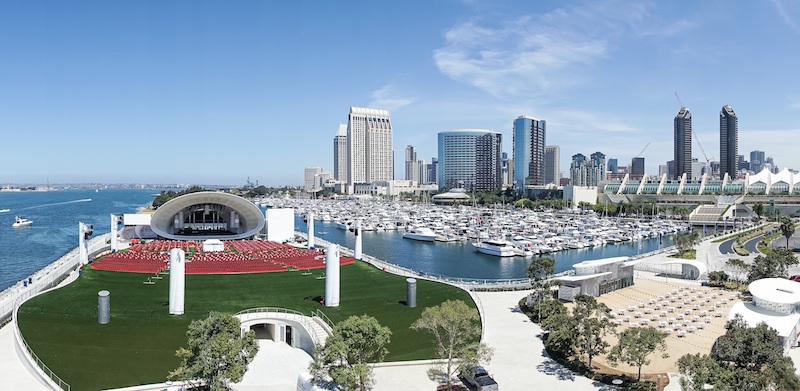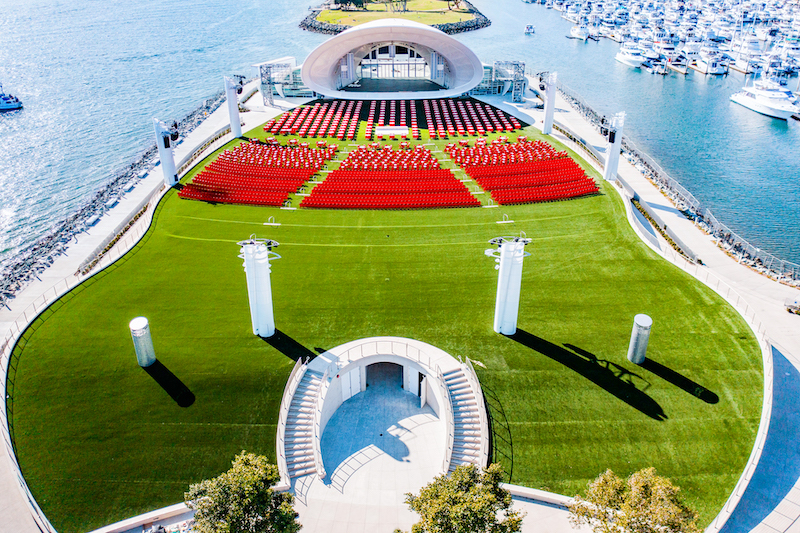This weekend, after a 13-month COVID related delay, the Rady Shell at Jacobs Park, developed and managed by the San Diego Symphony, officially opens on 3.7 acres of the city’s downtown Embarcadero district.
The $85 million Rady Shell at Jacobs Park, designed by the project’s Lead Architect and AOR Tucker Sadler Architects, is the first permanent venue for the Symphony’s schedule of outdoor classical concerts. It aspires to be the same kind of draw as the Hollywood Bowl in Los Angeles, the nation’s only other year-round outdoor concert venue operated by an orchestra.
The park is accessible to the public for free 85% of the year, as the Symphony spent $3 million to rebuild and upgrade the adjacent basketball courts and outdoor athletic equipment at Embarcadero Marina Park South. It added 34 donor benches, which are illuminated at night and were built around the venue’s perimeter and along the promenade between the venue and the San Diego Convention Center.
AN INTERNATIONAL BUILDING TEAM

The Rady Shell is amplified by an on-stage sound system as well as a second system at each side of the stage and behind the audience.
With its flexible seating capacity of 10,000 within a 1.25-acre audience area, Rady Shell at Jacobs Park features walkways, open-air dining pavilions, and recreational facilities. The Shell itself showcases a 4,800-sf stage wrapped in a 33,000-sf canopy provided by Australia-based Fabritecture. U.K.-based Soundforms, with architects from Flanagan Lawrence, Expedition Engineers, and ES Global, designed the Performance Shell, expanding and adapting the concept to accommodate a large orchestra, chorus, and soloists. (The Rady Shell in San Diego is 57 ft high and 82 ft wide.) Tucker Sadler was responsible for the overall design of the venue at Jacobs Park, including backstage artist support, three professional kitchens, underground restrooms, the seating area, and the public park that offers views of San Diego Bay and the city's skyline.
The Rady Shell uses two acoustical systems designed by Salter in consultation with sound designer Shawn Murphy: an on-stage Meyer Constellation Acoustic system, and an L-Acoustics system that projects sound from six towers three on each side of the stage. JRLX and theater consultant Schuler Shook designed the venue’s lighting, and Solotech provided the audio-visual elements. An LED lighting system developed by Horton Lees Brogdon Lighting Design illuminates the exterior canopy.
PHILANTHROPIC OUTPOURING

The venue provides views of this city and its waterfront. Image: Sal Villanueva, Tucker Sadler Architects
Nearly all of the money raised to fund this project came from private donors including Qualcomm’s founder Irwin Jacobs, who proposed the idea for an outdoor concert space two decades ago, according to the San Diego Union Tribune. Rady Shell also brings the Symphony—which was founded in 1910 but in 1996 was forced to liquidate its assets under Chapter 7 of the U.S. Bankruptcy Code—full circle.
The Rady Shell at Jacobs Park is designed to host more than 100 concerts and events year-round.
Other members of this project’s Building Team include Gardiner & Theobald (project manager), Coffman Engineers (SE), and Burton Studios (landscape architect).
Related Stories
| Apr 12, 2011
Long-awaited San Francisco center is music to jazz organization’s ears
After 28 years, SFJAZZ is getting its first permanent home. The San Francisco-based nonprofit, which is dedicated to advancing the art of jazz through concerts and educational programs, contracted local design firm Mark Cavagnero Associates and general contractor Hathaway Dinwiddie to create a modern performance center in the city’s Hayes Valley neighborhood
| Apr 12, 2011
Entrance pavilion adds subtle style to Natural History Museum of Los Angeles
A $13 million gift from the Otis Booth Foundation is funding a new entrance pavilion at the Natural History Museum of Los Angeles County. CO Architects, Los Angeles, is designing the frameless structure with an energy-efficient curtain wall, vertical suspension rods, and horizontal knife plates to make it as transparent as possible.
| Apr 5, 2011
Zaha Hadid’s civic center design divides California city
Architect Zaha Hadid is in high demand these days, designing projects in Hong Kong, Milan, and Seoul, not to mention the London Aquatics Center, the swimming arena for the 2012 Olympics. But one of the firm’s smaller clients, the city of Elk Grove, Calif., recently conjured far different kinds of aquatic life when members of the City Council and the public chose words like “squid,” “octopus,” and “starfish” to describe the latest renderings for a proposed civic center.
| Mar 11, 2011
Chicago office building will serve tenants and historic church
The Alter Group is partnering with White Oak Realty Partners to develop a 490,000-sf high-performance office building in Chicago’s West Loop. The tower will be located on land owned by Old St. Patrick’s Church (a neighborhood landmark that survived the Chicago Fire of 1871) that’s currently being used as a parking lot.
| Feb 11, 2011
Sustainable features on the bill for dual-building performing arts center at Soka University of America
The $73 million Soka University of America’s new performing arts center and academic complex recently opened on the school’s Aliso Viejo, Calif., campus. McCarthy Building Companies and Zimmer Gunsul Frasca Architects collaborated on the two-building project. One is a three-story, 47,836-sf facility with a grand reception lobby, a 1,200-seat auditorium, and supports spaces. The other is a four-story, 48,974-sf facility with 11 classrooms, 29 faculty offices, a 150-seat black box theater, rehearsal/dance studio, and support spaces. The project, which has a green roof, solar panels, operable windows, and sun-shading devices, is going for LEED Silver.
| Feb 11, 2011
BIM-enabled Texas church complex can broadcast services in high-def
After two years of design and construction, members of the Gateway Church in Southland, Texas, were able to attend services in their new 4,000-seat facility in late 2010. Located on a 180-acre site, the 205,000-sf complex has six auditoriums, including a massive 200,000-sf Worship Center, complete with catwalks, top-end audio and video system, and high-definition broadcast capabilities. BIM played a significant role in the building’s design and construction. Balfour Beatty Construction and Beck Architecture formed the nucleus of the Building Team.
| Feb 11, 2011
Kentucky’s first green adaptive reuse project earns Platinum
(FER) studio, Inglewood, Calif., converted a 115-year-old former dry goods store in Louisville, Ky., into a 10,175-sf mixed-use commercial building earned LEED Platinum and holds the distinction of being the state’s first adaptive reuse project to earn any LEED rating. The facility, located in the East Market District, houses a gallery, event space, offices, conference space, and a restaurant. Sustainable elements that helped the building reach its top LEED rating include xeriscaping, a green roof, rainwater collection and reuse, 12 geothermal wells, 81 solar panels, a 1,100-gallon ice storage system (off-grid energy efficiency is 68%) and the reuse and recycling of construction materials. Local firm Peters Construction served as GC.
| Feb 11, 2011
Former Richardson Romanesque hotel now houses books, not beds
The Piqua (Ohio) Public Library was once a late 19th-century hotel that sat vacant and deteriorating for years before a $12.3 million adaptive reuse project revitalized the 1891 building. The design team of PSA-Dewberry, MKC Associates, and historic preservation specialist Jeff Wray Associates collaborated on the restoration of the 80,000-sf Richardson Romanesque building, once known as the Fort Piqua Hotel. The team restored a mezzanine above the lobby and repaired historic windows, skylight, massive fireplace, and other historic details. The basement, with its low ceiling and stacked stone walls, was turned into a castle-like children’s center. The Piqua Historical Museum is also located within the building.
| Feb 11, 2011
Sustainable community center to serve Angelinos in need
Harbor Interfaith Services, a nonprofit serving the homeless and working poor in the Harbor Area and South Bay communities of Los Angeles, engaged Withee Malcolm Architects to design a new 15,000-sf family resource center. The architects, who are working pro bono for the initial phase, created a family-centered design that consolidates all programs into a single building. The new three-story space will house a resource center, food pantry, nursery and pre-school, and administrative offices, plus indoor and outdoor play spaces and underground parking. The building’s scale and setbacks will help it blend with its residential neighbors, while its low-flow fixtures, low-VOC and recycled materials, and energy-efficient mechanical equipment and appliances will help it earn LEED certification.
| Feb 11, 2011
Texas megachurch inspired by yesteryear’s materials, today’s design vocabulary
The third phase of The First Baptist Church of Pasadena, Texas, involves construction of a new 115,000-sf worship center addition. Currently in design by Zeigler Cooper, the project will include a 2,500-seat worship center (with circular layout and space for a 50-person orchestra and 200-person choir), a 500-seat chapel (for weddings, funerals, and special events), and a prayer room. The addition will connect to the existing church and create a Christian Commons for education, administration, music, and fellowship. The church asked for a modern design that uses traditional materials, such as stone, brick, and stained glass. Construction is scheduled to begin this summer.

















